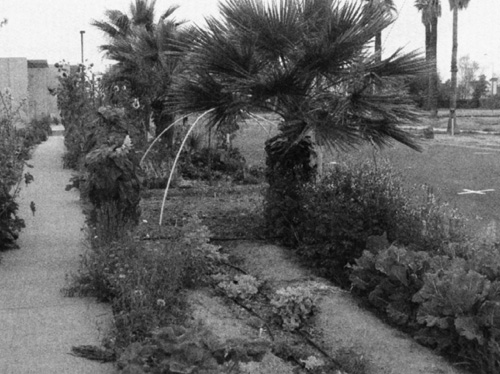
This Article From Issue
January-February 2012
Volume 100, Number 1
Page 80
DOI: 10.1511/2012.94.80
BIRD ON FIRE: Lessons from the World’s Least Sustainable City. Andrew Ross. xii + 297 pp. Oxford University Press, 2011. $27.95.
Many dozens of cities in the United States claim to be making serious and concerted efforts to become more sustainable. Phoenix, the subject of Andrew Ross’s Bird on Fire, is one of them. Yet Ross, who is a professor in the Department of Social and Cultural Analysis at New York University, has decided to throw a bucket of cold water on any enthusiasm such claims might engender.
The book’s title is meant to conjure both the image of the mythical bird that periodically spontaneously combusts and the city in the Sonoran Desert that may well be one of those most seriously affected by rising temperatures associated with climate change. The title may even be an allusion to the similarly titled 2008 movie Man on Wire, which documents Philippe Petit’s daring and unlikely feat of walking a tightrope between the World Trade Center’s twin towers in New York City in 1974. The book’s subtitle refers to Phoenix as “the world’s least sustainable city.” Although Ross acknowledges that “some will quibble over this designation,” he maintains that even if it is not the least sustainable city, “it is a very close contender.”

The book is an important treatise documenting the true political challenges facing this part of Arizona in any attempt to change existing patterns of economic development and associated political behavior. Indeed, Bird on Fire is first and foremost about the interrelated nature of local, regional, state and national politics. Ross shows how existing political forces have conspired to undermine often well-intentioned efforts to move toward policies, programs and individual behaviors more consistent with the pursuit of sustainability. This is a book that many of my colleagues might refer to as a “this happened and that happened” description primarily of local and state politics. Based on a close reading of history and on more than 200 personal interviews with city, metropolitan and state leaders, the book comes with no academic baggage, no social or political theory to speak of, and little in the way of explicit prescriptions—just the facts as Ross sees them with some modest inferences about what these facts represent.
The first chapter, “Gambling at the Water Table,” sets the stage for the entire book. It documents the historical roots of the city’s commitment, in both culture and policies, to “the growth machine” and demonstrates the symbiotic relationship between developers and policy makers, who have behaved as though water is and always will be plentiful and cheap. In the Phoenix metropolitan area, the growth machine has produced expansive housing development, promoting rapid population growth without enough water to support that growth.
Chapter 2, “The Road Runner’s Appetite,” examines the roots of this growth- machine mentality and takes it to task for having a “checklist approach to sustainability”: City leaders cherry-pick policies and programs from a list so that they can say they are pursuing sustainability while avoiding making the hard choices. Even in the face of the housing bust that started in 2007, the mindset of promoting the construction primarily of single-family housing has been pervasive.
Chapter 3, “The Battle for Downtown,” describes the role of Phoenix’s artist-activist community in promoting a number of sustainable development projects in the central city. Efforts there are contrasted with those in other parts of the city, which are hampered by serious political tensions between the more affluent northern part and the disadvantaged southern part, which is populated largely by members of racial and ethnic minorities. Ross questions whether the pursuit of sustainability can ever really serve all the people of a city. Is it inevitable that some people (the poor) will get left out? More on this issue later.
Chapter 4, “Living Downstream,” is not just about the challenges of relying on upstream water sources that are often gone by the time they reach Phoenix. It is also about a city living with a legacy of contamination from the mid-20th-century industrial and manufacturing age. When high-tech and electronics companies such as Motorola eventually abandoned their plants in the area for more lucrative opportunities overseas, Phoenix was left with serious and pervasive hazardous-waste problems. This chapter also documents the differential impact of such legacies on native populations and other minority groups.
Chapter 5, “The Sun Always Rises,” examines the challenges metropolitan Phoenix has faced in its efforts to rebuild its economy around green jobs, with a special emphasis on solar power. Political forces largely outside the city itself have opposed the city’s efforts to rely on renewable energy, first undermining and then thwarting them.
Chapter 6, “Viva Los Suns,” sets the stage for an in-depth analysis of the importance of cultural tensions between the Anglo population and populations of Native Americans and immigrants. And Chapter 7, “Land for the Free,” focuses primarily on efforts by the Gila River Indian Community (GRIC) to restore the water rights and access that they enjoyed years earlier, before the water was diverted to support the growth machine. Indeed, these two chapters argue that returning this water to traditional agricultural practices and uses constitutes the only true progress toward sustainability that has been made in the Phoenix area. These chapters also complete the book’s argument that the pursuit of sustainability, in the absence of an understanding of sustainability as promoting environmental justice, is false and inevitably flawed.
In “Delivering the Good,” the concluding chapter, Ross notes that
The GRIC water settlement brought a long struggle for environmental justice to a triumphant conclusion. Delivering justice meant that a large portion of the region’s available resources would be sequestered from the growth machine. Instead of supplying a new generation of low-density tract housing, the water could now be used to produce healthy, local food for the area population, and, if nonindustrial agriculture prevailed, the result would be a double win for carbon reduction. Surely this is how a green polity ought to act, redressing claims of those who have been aggrieved, and doing it in a way that extends long-term benefits for all.
With any in-depth case study, the issue arises of whether and to what extent the observations made are generalizable. The book’s subtitle refers to “lessons,” implying that something can be learned from events in Phoenix that can be applied elsewhere. Yet the book doesn’t discuss this, and the reader is left to his or her own devices to extrapolate these lessons. Does the book have anything to say that is relevant to the politics of sustainability in, say, Louisville, Kentucky, or Wichita, Kansas? Most U.S. cities are not located in a desert; most have not experienced periods of housing boom and bust as great as those that have occurred in Phoenix, nor have they been dominated by the same kind of growth-machine mentality; most cities have very different relationships with their respective metropolitan and state governments; and cities differ greatly in the characteristics of civil society found in them. All of these factors might very well conspire to limit the generalizability of the book’s lessons. Nevertheless, Ross’s discussions of political, social and economic influences on the pursuit of sustainability are powerful and compelling, and his effort to demonstrate the practical link between the pursuit of sustainability and environmental justice is laudable.
At a minimum, Bird on Fire stands as an important corrective to myriad works that serve as cheerleaders for a progressive agenda. I consider it a must-read for anyone who thinks that city transitions to more sustainable policies and practices are a snap. When I next teach my seminar on the politics of sustainable cities, this book will be required reading.
Kent E. Portney is a professor of political science at Tufts University. He is the author of several books, including Taking Sustainable Cities Seriously: Economic Development, the Environment, and Quality of Life in American Cities (The MIT Press, 2003), and most recently is coauthor with Susan A. Ostrander of Acting Civically: From Urban Neighborhoods to Higher Education (Tufts University Press, 2007).

American Scientist Comments and Discussion
To discuss our articles or comment on them, please share them and tag American Scientist on social media platforms. Here are links to our profiles on Twitter, Facebook, and LinkedIn.
If we re-share your post, we will moderate comments/discussion following our comments policy.